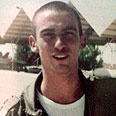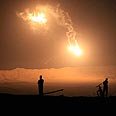Thursday morning saw an expansion of the search for a pilot and navigator whose F-16I plane crashed in the Ramon crater late Wednesday night during a training flight. They are missing and presumed dead.
The Israel Defense Forces has estimated that the crash was the result of human error, but a few days are needed in order to establish this. Meanwhile, Air Force chief Ido Nehushtan has ordered an investigation committee to be set up and headed by an officer of a colonel rank.
Nehushtan arrived at the scene of the crash on Thursday morning in order to supervise search efforts. Rabbis from the Chief Rabbinate were also on the scene, in case body parts are found. Parts of the jet were also being collected for analysis.
In the afternoon, the IAF commander arrived at the homes of the two missing crewmen.
Tragically the pilot, 28-year old Amichay Itkis, from Sde Warburg, had an older brother, Barak, who was killed while serving as a young officer in the Navy in 1998. Barak dreamed of becoming a pilot in the Air Force, but suffered vision impairment that denied him the job.
Emanuel Levy, the navigator, is 30 years old and a resident of Maale Adumim.
Itkis was the deputy commander of his squadron and recently left the position in order to complete academic studies. He was recently engaged to be married.
Levy was stationed in IDF Headquarters in Tel Aviv, but both continued to carry out regular training flights as per IAF standards.
Emanuel Levy's mother told Ynet on Thursday morning, "I believe in miracles. Perhaps God in the sky will save him. They haven't found bodies yet and I'm praying for a miracle. He may still be alive."
wa.jpg)
Scene of crash, Thursday morning
Soldiers and rescue forces searched the area throughout the night for pieces of the fallen plane. They said one of the problems encountered in the search is the sandy bottom of the crater, in which metallic particles have been lodged, making a search from the air difficult.
Four F-16I aircraft, the air force's newest plane, took part in routine training over the Ramon Crater in good weather. At some point, one of the planes suddenly fell to the ground from a height of 4,000 meters (13,000 feet), apparently failing to report any problem before the disaster. Another aircraft observed the plunge but apparently did not realize it would hit the ground.
'IAF's most advanced aircraft'
It appears that human error was the cause of the accident, perhaps loss of orientation, but all other planes of this type were grounded immediately. Within a few days it should be possible to rule out technical fault as the cause of the disaster.
The aircraft took off at about 8 pm for a training exercise. The IDF lit up the area using flares in efforts to locate the pilots. Police rescue units were also called.
Former Air Force Commander Major-General (res.) Avihu Ben-Nun told Ynet that the F-16I was the IAF's most advance aircraft. "Its combat systems are among the most diverse, as are its defense systems. Its engine is very reliable, and only a small number of failures and accidents have been recorded throughout its history.
"I can't say it's the safest plane the Air Force has," Ben-Nun added, "but it's definitely very safe. This is the last warplane model we've received, with the most advanced means, and highly impressive performance and range abilities."
Yair Altman, Yoav Zitun, Boaz Fyler, Aviel Magnezi and Ilana Curiel contributed to this report
- Follow Ynetnews on Facebook


















